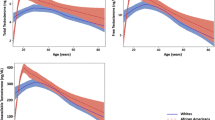Abstract
Purpose
We evaluated the association between clinically assessed periodontal disease and serum prostate-specific antigen (PSA) concentration in men without a prostate cancer diagnosis in a US nationally representative sample of non-institutionalized men.
Methods
Included were 1263 men aged ≥ 40 years who participated in the National Health and Nutrition Examination Survey in 2009–2010. Measurements of periodontal health and tooth count were used to define periodontal disease severity (no, mild, moderate, severe) and edentulism. Linear and logistic regressions were used to estimate the association of periodontal disease severity and edentulism with PSA concentration and elevated PSA, respectively.
Results
Adjusting for age and other factors including race, body mass index, and education, the natural logarithm of PSA concentration did not change with increasing severity (mild − 0.20, 95% confidence interval [CI] − 0.34 to − 0.05; moderate − 0.12, 95% CI − 0.26 to 0.01; severe − 0.16, 95% CI − 0.43 to 0.12; edentulism − 0.16, 95% CI − 0.35 to 0.04; P-trend 0.13) compared with dentate men without periodontal disease. Although the multivariable-adjusted ORs of elevated PSA were not statistically significant, participants with more severe periodontal disease were less likely to have PSA > 2.0 and > 2.5 ng/mL, but more likely to have PSA > 4.0 ng/mL, compared to dentate men without periodontal disease. Similar non-significant associations with PSA were observed when comparing edentulous men to dentate men without periodontal disease.
Conclusions
In this US nationally representative sample, men with periodontal disease did not have higher serum PSA and were not more likely to have clinically elevated PSA after taking into account age and other factors, contrary to the hypothesis. This study suggests that periodontal disease does not notably affect the specificity of PSA for prostate cancer screening.
Similar content being viewed by others
References
Thompson IM, Pauler DK, Goodman PJ et al (2004) Prevalence of prostate cancer among men with a prostate-specific antigen level ≤ 4.0 ng per milliliter. N Engl J Med 350(22):2239–2246
Barry MJ (2001) Clinical practice. Prostate-specific-antigen testing for early diagnosis of prostate cancer. N Engl J Med 344(18):1373–1377
Nadler RB, Humphrey PA, Smith DS, Catalona WJ, Ratliff TL (1995) Effect of inflammation and benign prostatic hyperplasia on elevated serum prostate specific antigen levels. J Urol 154:407–413
Haffajee AD, Socransky SS (2000) Microbial etiological agents of destructive periodontal diseases. Periodontol 1994(5):78–111
Page RC, Offenbacher S, Schroeder HE, Seymour GJ, Kornman KS (2000) Advances in the pathogenesis of periodontitis: summary of developments, clinical implications and future directions. Periodontol 1997(14):216–248
Joshi N, Bissada NF, Bodner D et al (2010) Association between periodontal disease and prostate-specific antigen levels in chronic prostatitis patients. J Periodontol 81:864–869
Alwithanani N, Bissada NF, Joshi N et al (2015) Periodontal treatment improves prostate symptoms and lowers serum PSA in men with High PSA and chronic periodontitis. Dentistry 05:284.
Kruck S, Hennenlotter J, Amend B et al (2017) Chronic periodontitis does not impact serum levels of prostate-specific antigen. Anticancer Res 37:3163–3167
Eke PI, Thornton-Evans GO, Wei L, Borgnakke WS, Dye BA, Genco RJ (2018) Periodontitis in US adults: National Health and Nutrition Examination Survey 2009-2014. J Am Dent Assoc 149(576–588):e576
Zipf G, Chiappa M, Porter KS, Ostchega Y, Lewis BG, Dostal J (2013) National health and nutrition examination survey: plan and operations, 1999–2010. Vital Health Stat 1:1–37
Centers for Disease Control and Prevention (CDC). National Center for Health Statistics (NCHS). National Health and Nutrition Examination Survey Examination Protocol. Hyattsville, MD: U.S. Department of Health and Human Services, Centers for Disease Control and Prevention. site]. Available at https://wwwn.cdc.gov/nchs/data/nhanes/2009-2010/manuals/OralHealth_Examiners.pdf
Eke PI, Page RC, Wei L, Thornton-Evans G, Genco RJ (2012) Update of the case definitions for population-based surveillance of periodontitis. J Periodontol 83:1449–1454
Gilbert SM, Cavallo CB, Kahane H, Lowe FC (2005) Evidence suggesting PSA cutpoint of 2.5 ng/mL for prompting prostate biopsy: review of 36,316 biopsies. Urology 65(3):549–553
Michaud DS, Liu Y, Meyer M, Giovannucci E, Joshipura K (2008) Periodontal disease, tooth loss, and cancer risk in male health professionals: a prospective cohort study. Lancet Oncol 9:550–558
Michaud DS, Lu J, Peacock-Villada AY et al (2018) Periodontal disease assessed using clinical dental measurements and cancer risk in the ARIC Study. J Natl Cancer Inst 110:843–854
Lee JH, Kweon HH, Choi JK, Kim YT, Choi SH (2017) Association between periodontal disease and prostate cancer: results of a 12-year longitudinal cohort Study in South Korea. J Cancer. 8:2959–2965
Cheng WC, Saleh F, Abuaisha Karim B, Hughes FJ, Taams LS (2018) Comparative analysis of immune cell subsets in peripheral blood from patients with periodontal disease and healthy controls. Clin Exp Immunol 194:380–390
Sabarish R, Rao SR, Lavu V (2016) Natural T regulatory cells (n Treg) in the peripheral blood of healthy subjects and subjects with chronic periodontitis—a pilot study. J Clin Diagn Res 10(3):ZC36
Funding
This work was supported in part by the National Cancer Institute (P30 CA006973, Nelson) and the Maryland Cigarette Restitution Fund at Johns Hopkins.
Author information
Authors and Affiliations
Corresponding author
Ethics declarations
Conflict of interest
The authors declare that they have no conflict of interest.
Additional information
Publisher's Note
Springer Nature remains neutral with regard to jurisdictional claims in published maps and institutional affiliations.
Rights and permissions
About this article
Cite this article
Huang, Y., Michaud, D.S., Lu, J. et al. The association between clinically determined periodontal disease and prostate-specific antigen concentration in men without prostate cancer: the 2009–2010 National Health and Nutrition Examination Survey. Cancer Causes Control 30, 1293–1300 (2019). https://doi.org/10.1007/s10552-019-01238-3
Received:
Accepted:
Published:
Issue Date:
DOI: https://doi.org/10.1007/s10552-019-01238-3




